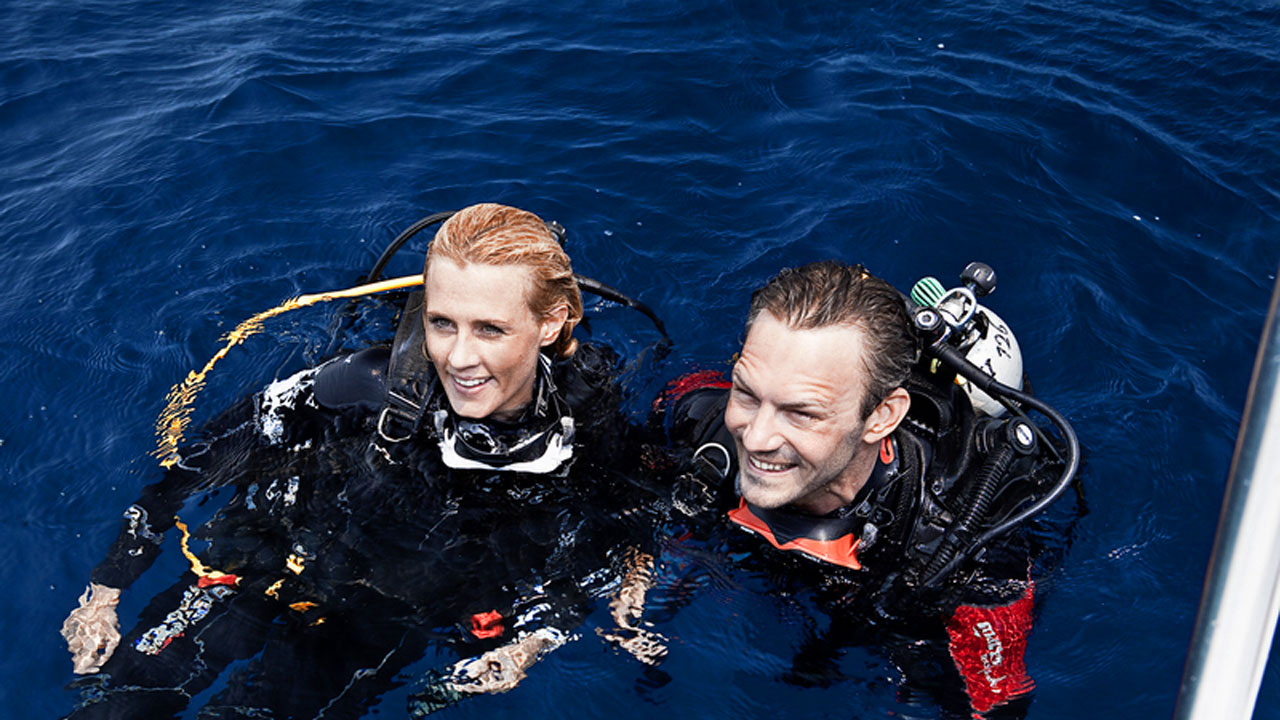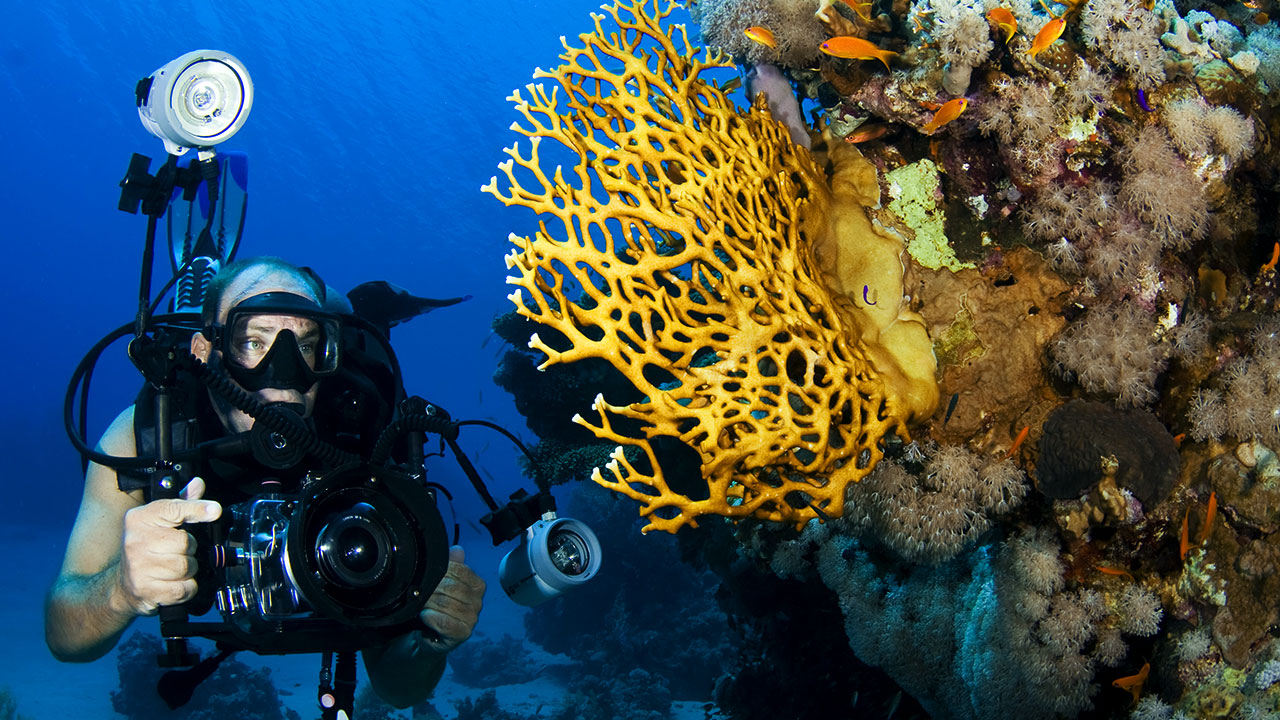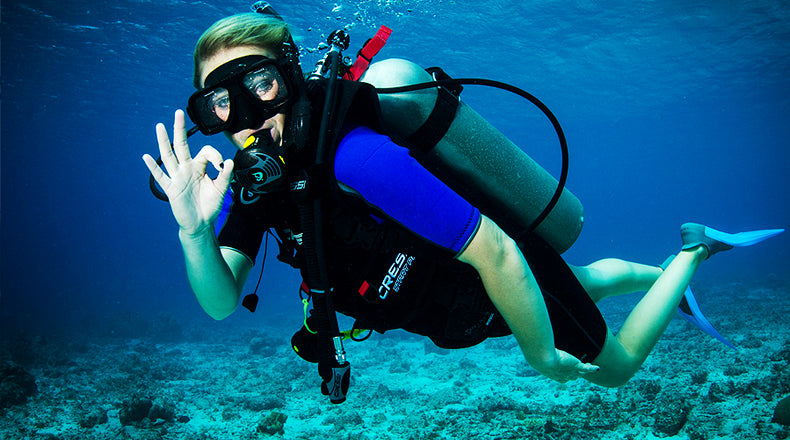Diver Communication in Low Visibility

Good communication between dive buddies is essential to a safe and enjoyable dive. Signaling can help you to communicate intentions, give direction, ask your dive buddy if they’re okay, how much air they have, or inform them about a problem. The most common method of underwater communication is through hand signals. However, such factors as darkness, silt, or plankton can affect the visibility underwater in a negative way and hamper your ability to communicate effectively. So what do you do, if there is a risk you may not be able to use hand signals? Let’s look at a few alternative methods of communication that you can use depending on dive conditions.
Torch Signals
Light signals prove to be the most effective and easy to perform in low visibility conditions, especially during night or cave diving. Although there are only a few torch signals, they are usually enough to attract attention and communicate some basic messages.
Signaling a circle with your torch represents “OK”. This same signal can be used both as a question (“are you OK?”) and as a reply (“I am OK”). If your buddy does not respond to your signal, you should find out why. While it is possible that your buddy may be simply looking elsewhere, failure to respond can also mean that he/she is struggling with something or is unconscious.
To attract your buddy’s attention wave your torch up and down. Use this signal in a slow and controlled motion, as it means that your message is not urgent, for instance when you want to point out some cool critter or communicate direction. Another way to call attention to something is to make a circle around your buddy’s beam to sort of "lasso" it and then "drag" it to where you want your buddy to look.
If you need to signal an emergency, make a quick, repeated back and forth horizontal motion. Remember though, some divers do not make the distinction between horizontal and vertical flashing signals. What’s more, if the diver, doing the signaling is panicking, he/she may forget about the existence of any such distinction. Therefore, it is best to assume that all sudden, fast light flashings from your buddy are emergency signals, until proven otherwise.
You can also communicate by making hand signals in front of your torch. Face the torch light to your chest and away from your eyes not to blind yourself.

Light Signal “OK”

Light Signal “Attention”

Light Signal “Emergency”

Light used to illuminate hand signals
Images by Mikkelbg - Own work, CC BY-SA 3.0
Remember, when you are making light signals, or for that matter any time you see your buddy looking in your direction, take care not not to shine your light directly in your buddy's face. Point your light down or off to the side to spare him/her the full force of the glare.
Another thing to keep in mind is that all your normal light movements should be smooth, slow, and controlled. If you make too many unnecessary, random motions with your torch, your buddy can mistake them for light signals. What’s more, you risk to stay unnoticed when you really do need to get your buddy’s attention, as he/she may learn to ignore your frantic light movements.
In case you become separated from your buddy, the light can also help you find each other. Get vertical and shine your light outward while turning a full circle. Your buddy should do the same and chances are you'll spot each other. If you surface away from the dive boat, you should point your light at the boat until you get the crew's attention. When you see that someone has noticed you, shine the torch down on your head so the crew can see you clearly.
Make sure you know these simple torch signals and always review them with your buddy or other divers in your dive team before entering the water.
Sound Signals
Sound signals are generally not as effective as light signals. First of all, unless you are using any special underwater communication systems that allow divers to talk to each other, there is very little you can convey through sound. Certainly, you can attract your buddy’s attention by banging on your tank or using noise makers. However, as you probably know, distance and direction to a sound source are extremely difficult to determine underwater, so even if your buddy hears you, he/she may not be able to find you. What’s more, if you are diving in currents, high flow will have the same effect as wind, and literally sweep the sounds away.
Rope Signals
If the visibility at the site you are diving is below 2 meters (6.5 feet) you should consider using a buddy line to maintain good contact with your partners. Furthermore, in case the visibility is below 1 meter (3.2 feet), it is recommended that you attach a lifeline from the surface to either yourself or your buddy.
So, if you are using a buddy line and/or a lifeline you can communicate with your fellow divers or even a tender on the surface, using a rope. Generally, there is no standard unified rope signal system. Different organizations may use slightly different signals. For example, the British Sub-Aqua Club uses the following signals:
- 1 pull – are you OK? reply 1 pull – Yes I am OK
- 2 pulls – Stay put reply 2 pulls – I am stationary
- 3 pulls – Go down reply 3 pulls – I am going down
- 4 pulls – Come up reply 4 pulls – I am coming up
- 5 or more pulls – Emergency: bringing you to the surface or Emergency: bring me to the surface (no reply required)
Furthermore, if you and your buddy are swimming along the line, within arm reach from one another, you can also use touch contact. The basic touch-contact signals are "Stop," "Go," and "Back up." If the rear diver pushes on the lead diver's arm or leg, it means, "Go" (and also, implicitly, is signalling that everything's okay). If he/she pulls, it means, "Stop." Successive pulling movements mean, "Back up." If the "Back up" movements are repeated and intense, the rear diver may be signaling for assistance.
Other organizations may use different signals. So, make sure to discuss what type of signals you will use and what they mean.




